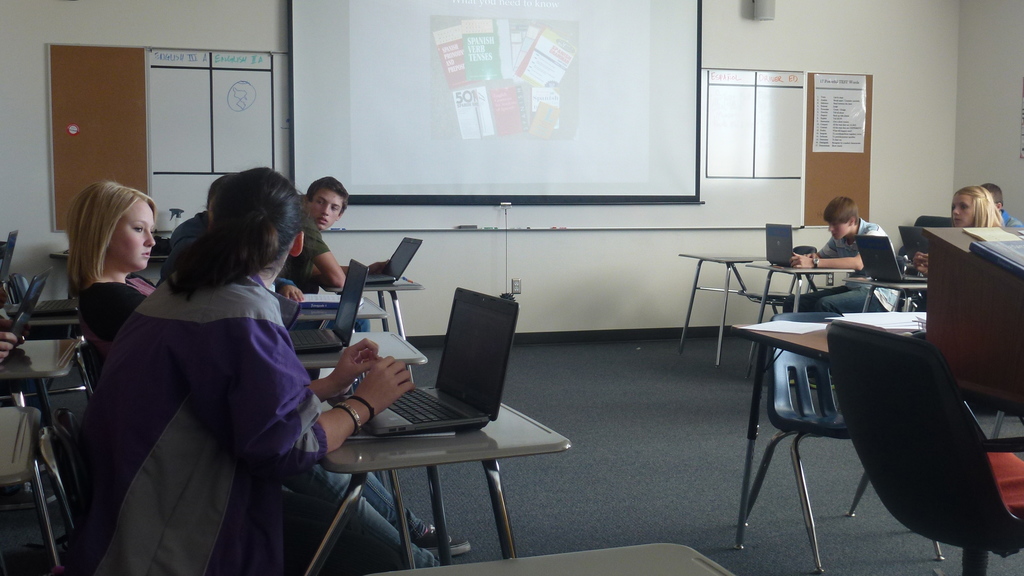At midday Monday, Emmett School District technology director Ken Loftus received an unexpected email: workers would be at the high school the next morning installing WiFi.
“I must say, very short notice,” district superintendent Wayne Rush said Monday afternoon.
Meanwhile, Vallivue High School is waiting for word on when it will receive its state-provided WiFi service. An October target date came and went. The school district paid to set up WiFi hotspots on campus as a short-term fix, while waiting on the state.

The WiFi rollout has also sprung some surprises on the state’s contractor, Education Networks of America. The job of rigging up WiFi in more than 200 high schools and junior high schools — all with different demands and different levels of technological expertise — has been “eye-opening,” said Garry Lough, ENA’s Idaho director of customer services.
ENA is three months into the job; under its contract with the state, the installation must be finished by March 15. ENA has finished work at about 30 schools so far, but Lough still says the company is on pace to meet its deadline.
A contentious start
The WiFi project has been mired in controversy.
While the 2013 Legislature earmarked $2.25 million for the project, some lawmakers publicly criticized Superintendent of Public Instruction Tom Luna for making this budget line item the springboard for a multiyear contract. With potential extensions and cost increases, the contract with ENA could run 15 years and cost $33.3 million.
The selection of ENA also came under scrutiny. The Nashville, Tenn.-based company was not the lowest bidder on the contract; Tek-Hut Inc. of Twin Falls bid $1.65 million, compared to ENA’s winning $2.11 million bid. Critics have also pointed to ENA’s political connections. Since 2010, ENA has made nearly $40,000 in campaign contributions to Luna, Gov. Butch Otter and 42 sitting legislators; Lough, meanwhile, is a former Luna staffer and state GOP official.
Whether this results in closer Statehouse scrutiny — it’s up to the Legislature to fund the WiFi contract, on an annual basis — both Luna and ENA are thinking long-term.
Luna’s 2014-15 budget proposal includes $2.4 million to fund the second year of the contract. Once ENA finishes hooking up the schools that have already signed up for WiFi, Lough said, his company’s work will shift toward system support.
But not entirely. A handful of administrators have reconsidered and want ENA to install WiFi in their schools. These districts will have to wait until the first round of hookups are completed.
A juggling act
The prospect of getting WiFi technology, on the state’s dime, has proven popular with cash-strapped local school officials. After the contract was awarded on July 25, school officials had eight days to decide whether to opt in for WiFi; 93 districts and 21 public charter schools did so.
That translates to a big assignment, even for a company with experience in Idaho school buildings. ENA completed the installation of the Idaho Education Network, a statewide broadband system, but it had four years to do the job and finished in three. This time, the company has seven months to install WiFi.
That isn’t the only obstacle. Choosing his words carefully, Lough says some districts are better prepared for the WiFi installation than others; “each one has a different skill set.” And every school official has his or her own idea about system specifications. Part of the job is striking a balance; setting up a system that meets local districts’ desires, while standardizing the systems enough that they can be easily maintained.
“If we have a ton of variables, it creates challenges,” said Lough.
The waiting game

Sugar Salem School District Superintendent Alan Dunn is a satisfied WiFi customer. His eastern Idaho high school could use some increased bandwidth, but that’s expected to be installed within the next few days. Aside from that, he said, the WiFi system “is working very well and meets our expectations.”
Dunn has another reason to be satisfied. Sugar Salem was the first school hooked up under the WiFi contract. The system went live in early September.
Other schools have had to play the waiting game.
- Meridian’s Compass Public Charter School has held off on handing out iPad Minis to its high school students — a key component of its $180,000 state technology pilot project — while waiting on WiFi. Workers were installing Compass’ wireless system Tuesday, school IT director Greg Cordero said.
- The Meridian School District signed up for WiFi at its 10 traditional high schools, academies and alternative high schools, but no installation date is set. The schools already have wireless service, but the new system will be faster. District information systems director Jerry Reininger hopes the installation will be complete by Christmas, but understands the statewide project will take time. “Not everybody is going to be hooked up in the first couple of months.”
- Work is in the “early stages” in Boise schools, district technology administrator David Roberts said. Part of the job is figuring out how the new equipment would sync with systems already in place in five high schools and eight junior high schools. But Roberts says the working relationship with ENA has been “very positive,” and he’s hoping the installation will be done by Christmas.
- Vallivue had long held off on installing WiFi in its high school, in anticipation of a state system, district technology director Shane Schamber said. But recently, the district set up about 25 WiFi hotspots — at a cost of about $100 apiece — to cover the cafeteria and gymnasium and some classrooms.
Lough said he wasn’t sure what caused the delay at Vallivue. But overall, he says ENA is on schedule.
It takes several steps to hook up a school — from surveys and engineering to installation and activation. Within the last week, wireless was installed or activated at 14 schools, and Lough said the company is on pace to meet an internal goal: to hook up 105 schools by year’s end.
But he understands that, for some schools, WiFi can’t come soon enough. “We try to do our best to accommodate everybody’s needs.”
